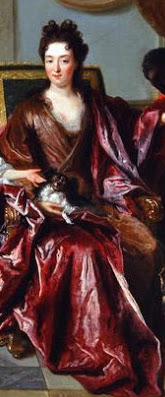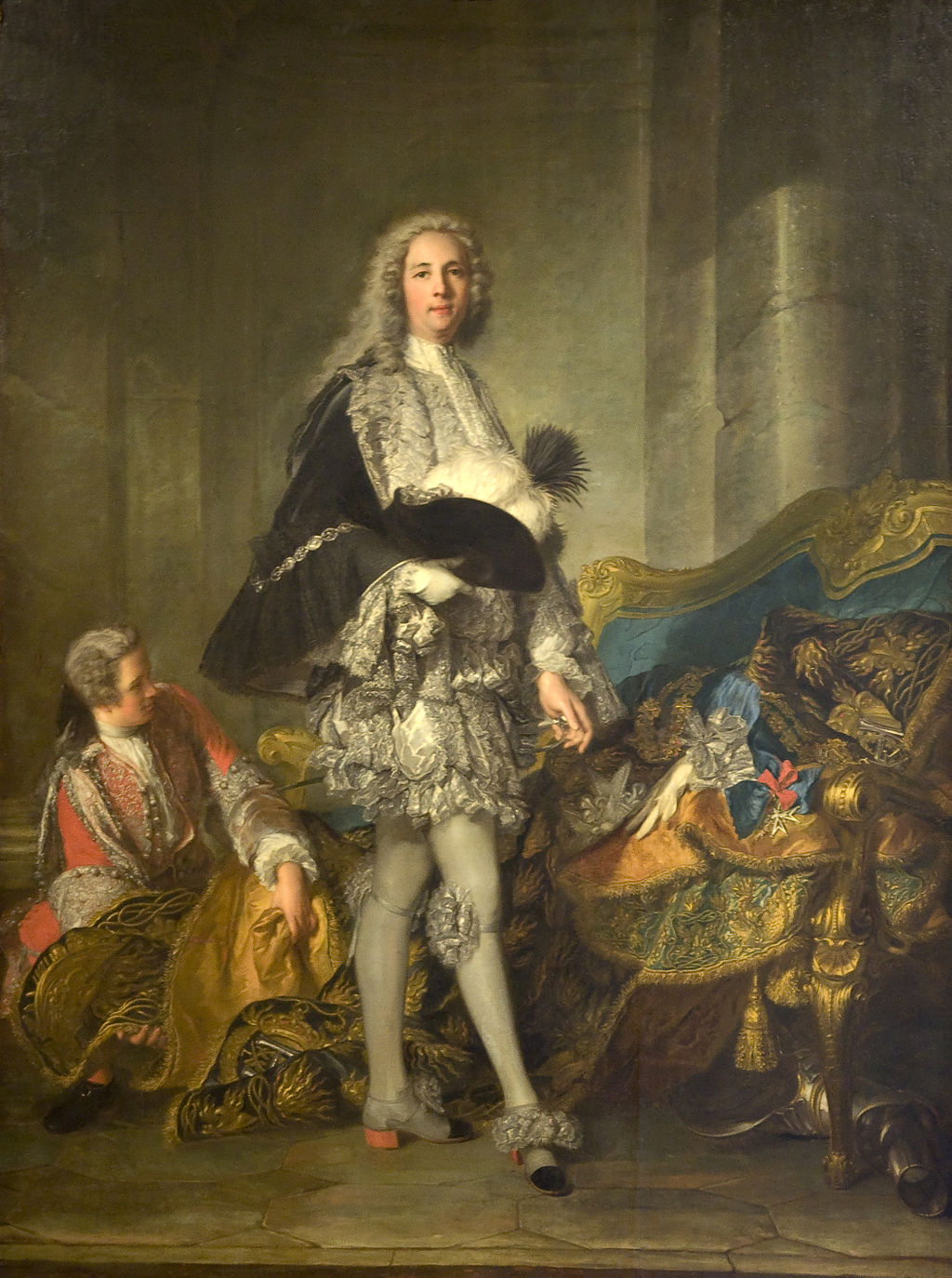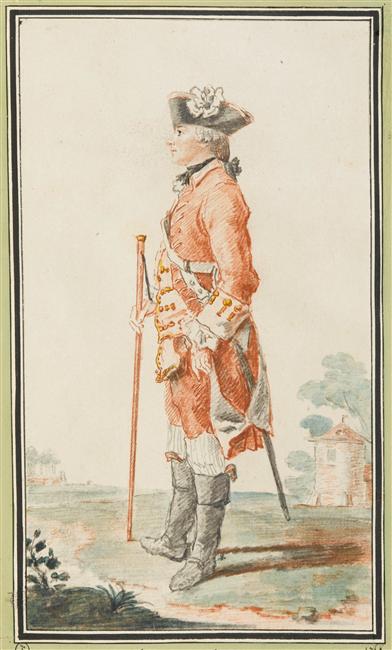Establishing themselves during Louis XIII, as the king's prime minister, Cardinal Richelieu set his family up amongst the leading families of France. As a cardinal, the first Duc de Richelieu had no children of his own to inherit the title and lands. Instead, he designated his brother's grandson as his heir.
Despite the celebrity of the name, the family was not as numerous in ducal incumbents as others - primarily due to how late in the ancien régime they were raised to the ducal class and the advanced ages of those who were granted that title.
1. Armand-Jean de Vignerot du Plessis & (1) Anne Poussard de Fors, (2) Anne-Marguerite d'Acigné, (3) Marguerite-Thérèse Rouillé
Armand-Jean was the son of François de Vignerot, who himself was the nephew of Cardinal Richelieu. Prior to assuming his great-uncle's title, he was both governor of Havre and General of the Galleys. His taste for high-living meant that he was quickly overcome with debt; he had to sell his generalcy of the galleys for 200.000. Throughout his life, his reckless financial decisions decimated his family's coffers which meant that every time he managed to get a lucrative appointment he would eventually have to sell it.
His first wife, Anne de Fors, was 21 years old when they married and already a widow. Despite being married for 35 years, the couple never had any children. When she died in 1684, this meant that the heir-less Armand-Jean had to remarry.
The second choice was Anne-Marguerite whose year of birth is unknown. She quickly fell pregnant and provided her husband with four children:
- Marie-Catherine-Armande, Comtesse de Clermont
- Élisabeth-Marguerite-Armande, nun
- Marie-Gabrielle-Élisabeth, nun
- Louis-François-Armand, Duc de Richelieu
 |
| Armand-Jean |
 |
| Marguerite- Thérèse |
2. Louis-François-Armand de Vignerot du Plessis de Richelieu & (1) Anne Catherine de Noailles, (2) Élisabeth Sophie de Lorraine, (3) Jeanne de Lavaulx
Louis-François-Armand was one of the most characteristic people of Louis XV's court. A notorious womanizer, remarkably intelligent and gifted on the battlefield, the Duc de Richelieu was perfect for a French courtier. He spent 22 years in the army where he reached the rank of Maréchal de France; at court, he managed to maintain the friendship of Louis XV, even after refusing Madame de Pompadour's marriage proposal for her daughter.
One might think that a man of the world such as Louis-François-Armand would be more focused on food, women and warfare than any more scholarly pursuits. Yet, he maintained a firm friendship with Voltaire and held seats at both the Académie Française and Académie des Sciences.
His first marriage was to Anne Catherine de Noailles, a member of the powerful court clan. The couple married while Louis XIV was still on the throne; the bride and bridegroom were both 15. After just five years of marriage, Anne Catherine died unexpectedly.
Considering that he was in prime marrying age - and without an heir - it is rather surprising that it took eighteen years for another marriage to be arranged. The new bride was from the house of Lorraine and had originally been betrothed to Paul II Esterházy but that match never materialised. Even though Élisabeth Sophie was marrying a duke, the house of Lorraine was considered to be far outranking the rather newly ducal house of Richelieu.
The couple had two children:
- Louis-Antoine-Sophie, Duc de Fronsac & Duc de Richelieu
- Jeanne-Sophie, Comtesse Pignatelli
Jeanne de Lavaulx had been married to a man more than twenty years her senior in 1764. Her first husband had made a fortune in the trade with the Far East before that venture went terribly wrong. Jeanne herself was considered to be stunningly beautiful and with a sound mind; she had had four children by her first husband when he died in 1772 during a diplomatic trip abroad.
Jeanne and Louis-François-Armand had actually had a chance encounter years before they were married. The Duc de Richelieu's carriage had broken down on the Pont-Neuf and the Comte and Comtesse de Lavaulx offered him a ride home. By this time in his life, the Duc de Richelieu was already notorious for his success with women; but, as he lamented, it was becoming unseemly to continue having affairs - without the respectability of also having a wife.
At the time of their marriage in 1772, Jeanne was 36 years old while her new husband was 76. Despite the staggering age-difference there appear to have been genuine affection between them; when her husband died in 1788, Jeanne was noted to be grief-stricken.
 |
| Louis-François-Armand |
 |
| Jeanne - after the death of her husband |
3. Louis-Antoine-Sophie de Vignerot du Plessis de Richelieu & (1) Adélaide-Gabrielle d'Hautefort, (2) Marie Antoinette de Galliffet
Born in 1736, Louis-Antoine-Sophie was brought up at court as his father's only male heir. When he reached a marriageable age, it was he whom Madame de Pompadour settled on for a match for her daughter, Alexandrine. Horrified at such a low mésalliance, the father of the prospective bridegroom claimed that as his wife was of the princely house of Lorraine; therefore, he needed approval from the head of the house. When Alexandrine died while still in her childhood, that matter was settled without further embarrassment for the Richelieu-family.
Louis was the last First Gentleman of the Chamber to the king. He had inherited the office from his father in 1756 and held it until 1791.
Adélaide-Gabrielle was the daughter of the Marquis d'Hautefort and granddaughter of the Duc d'Harcourt. The couple had a single child, together:
- Armand Emmanuel, Duc de Richelieu
Sadly, she died just three years after their marriage.
Louis-Antoine-Sophie waited nine years before he remarried. The bride was somewhat of an odd choice considering that the bridegroom was a duke. Marie Antoinette de Galliffet was the daughter of a count but not of a particularly great family.
She had two children by her Richelieu-husband:
- Armande-Marie, Marquise de Montcalm-Gozon
- Armande-Simplicie-Gabrielle, Marquise de Jumilhac
 |
| Louis-Antoine-Sophie |
Interesting facts/anecdotes:
- Louis-Antoine-Sophie had accumulated quite an impressive amount of titles and positions - as the only male heir of his family, he did not have to share. Besides Duc de Richelieu, he was Duc de Fronsac, Prince de Montagne, Marquis de Pont-Courlay, Comte de Cognac, Baron de Barbezieux, de Coze and Saugeon, First Gentleman of the King's Bedchamber, Maréchal de Camp and Lieutenant-General
- The family died out as late as 1952
- Armand-Jean had originally been on the side of the Condé during the Fronde but was eventually accepted back into the fold
- Speaking of Armand-Jean, he was amongst Louis XIV's tennis partners but apparently not a very apt one - he lost 25 of his precious paintings in a match with the Sun King
- Louis-François-Armand was - as mentioned - a notorious womanizer. Amongst his conquests were two daughters of the regent, the marquise du Châtelet, the princesse de Rohan, the baronne de Tencin etc.

